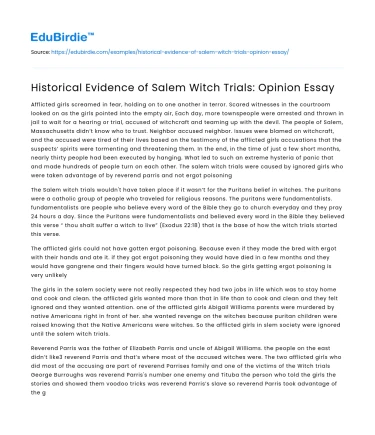Introduction
The Salem witch trials of 1692 represent a dark, yet fascinating chapter in American colonial history, marked by a series of hearings and prosecutions of people accused of witchcraft in colonial Massachusetts. These events have been subjects of enduring intrigue and debate, with scholars striving to understand the social, political, and psychological underpinnings of the trials. This essay seeks to explore the historical evidence of the Salem witch trials, examining their causes, the social dynamics at play, and the lasting impact on American society. Through a critical analysis of primary sources and scholarly interpretations, this essay will provide a nuanced understanding of the trials and argue that they were a culmination of complex social tensions and mass hysteria. In doing so, it will address various perspectives, including those that downplay the role of genuine belief in witchcraft, to present a holistic view of this historical phenomenon.
The Social and Political Context
The Salem witch trials did not occur in isolation but were deeply embedded in the social and political fabric of 17th-century New England. The Puritanical setting, characterized by a strict religious doctrine and an insular community, created an environment ripe for fear and suspicion. According to historian Paul Boyer, the trials coincided with a period of significant social upheaval, including economic distress, frontier wars, and political uncertainty following the Glorious Revolution in England (Salem Possessed, Boyer and Nissenbaum, 1974). These factors contributed to a climate of anxiety and a propensity to find scapegoats for societal woes.
Moreover, the religious fervor that permeated the region played a critical role in the witch trials. The Puritans' belief in the supernatural and the devil's presence on Earth made accusations of witchcraft plausible and terrifying. As historian John Demos notes, "The Puritan worldview was one in which the spiritual and the mundane were inextricably linked" (Entertaining Satan, Demos, 1982). This worldview, coupled with the testimonies of afflicted individuals who claimed to see specters of witches tormenting them, lent credence to the accusations. The trials, thus, reflected not only a judicial process but also a community grappling with its existential fears.
Individual Cases and Evidence
The trials were marked by numerous individual testimonies and confessions, which serve as critical evidence in understanding the hysteria's progression. One notable case is that of Tituba, a slave in the household of Reverend Samuel Parris, who was among the first to be accused of witchcraft. Her confession, which included vivid descriptions of encounters with the devil and flying on a broomstick, fueled the panic and inspired further accusations. As noted by historian Mary Beth Norton, Tituba's testimony was a turning point that "validated the fears of the community and set the stage for a cascade of accusations" (In the Devil's Snare, Norton, 2002).
The reliance on spectral evidence, where witnesses claimed to see the apparition of the accused committing maleficium, was another controversial aspect of the trials. This type of evidence, inherently subjective and unverifiable, led to numerous convictions and exacerbated the hysteria. The case of Rebecca Nurse, a respected elder, exemplifies the peril of such evidence. Despite her good standing in the community, Nurse was convicted primarily on the basis of spectral evidence, highlighting the trials' capacity to undermine social hierarchies and rational judgment. This reliance on dubious evidence has been critiqued by modern scholars as indicative of the broader societal anxieties and the breakdown of community trust.
Counter-Arguments and Historical Interpretations
While the mainstream historical narrative emphasizes mass hysteria and social tension as primary causes, some scholars argue that personal vendettas and local politics also significantly influenced the trials. Historian Chadwick Hansen, for instance, contends that the trials were not purely irrational but involved genuine belief in witchcraft and a legal system attempting to address real concerns (Witchcraft at Salem, Hansen, 1969). He suggests that the trials were a manifestation of Puritan efforts to maintain order and religious conformity in a rapidly changing world.
Furthermore, some interpretations focus on the role of gender in the witch trials, positing that the majority of the accused were women who defied traditional roles. Carol Karlsen, in her analysis, argues that the trials were a reflection of misogynistic attitudes and a means to control women who threatened the patriarchal norms (The Devil in the Shape of a Woman, Karlsen, 1987). This perspective suggests that the trials were not only about religious or social panic but also about reinforcing gender hierarchies.
Conclusion
The Salem witch trials, while a product of their time, continue to resonate as a powerful symbol of the dangers of mass hysteria and the breakdown of social cohesion. The historical evidence, comprising personal testimonies, court records, and contemporary accounts, reveals a complex interplay of social, religious, and political factors that fueled the witch hunt. While interpretations vary, the trials underscore the capacity for fear and prejudice to override reason and justice. By examining these events through multiple lenses, we gain insight into not only the trials themselves but also the enduring human propensity for scapegoating and the vulnerability of societal institutions in times of crisis. The lessons of Salem serve as a cautionary tale, reminding us of the importance of vigilance in safeguarding against similar occurrences in contemporary society.






 Stuck on your essay?
Stuck on your essay?

